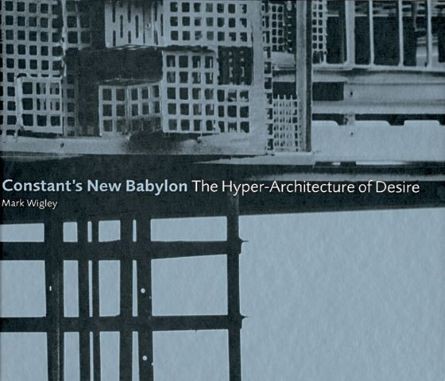Mark Wigley: Constant’s New Babylon: The Hyper-Architecture of Desire (1998)
Filed under book, catalogue | Tags: · architecture, capitalism, city, desire, situationists, urbanism

“From 1956 to 1974, the artist Constant Nieuwenhuys worked on a radical proposal for a future architecture. All traces of traditional buildings and social institutions would be abandoned. Everyone would drift through vast labyrinthine interiors and continuously reconstruct the spaces around them to satisfy any desire or stimulate new ones. Architecture becomes a pulsating display of group psychology. This monograph provides the first complete record of the project and includes a selection of texts by Constant and Guy Debord. Published on the occasion of the New Babylon retrospective at Witte de With, Rotterdam, in 1998.”
Publisher Witte de With, and 010 Publishers, Rotterdam, 1998
ISBN 9064503435, 9789064503436
256 pages
PDF (removed on 2018-12-5 upon request of image copyright holder)
Comments (2)Stanislaus von Moos, Chris Smeenk (eds.): Avant Garde und Industrie (1983) [English/German]
Filed under book | Tags: · aesthetics, architecture, art history, avant-garde, city, futurism, industry, machine, technology

Collected papers from a symposium held at the Department of Architecture at Delft University of Technology in May 1981.
Contributions in English from Niels L. Prak, Leonard K. Eaton, Tim Benton, and Jan van Geest; in German from Franziska Bollerey, Hanne Bergius, Stanislaus von Moos, Andreas Haus, Flip Bool, Martin Steinmann, and Otakar Máčel.
Publisher Delft University Press, Delft, 1983
ISBN 9062751091
176 pages
via TU Delft
PDF (29 MB)
Comment (0)Sigfried Giedion: Space, Time and Architecture (1941–)
Filed under book | Tags: · architecture, city, history of architecture, urbanism

“A milestone in modern thought, Space, Time and Architecture has been reissued many times since its first publication in 1941 and translated into half a dozen languages. It is a pioneering and influential standard history giving in integrated synthesis the background and cultural context of modern architecture and urban planning, set in their manifold cultural relationships “with other human activities and the similarity of methods that are in use today in architecture, construction, painting, city planning and science.”
The book had its genesis in the Charles Eliot Norton Lectures at Harvard University in the spring of 1938, and it was recognized from the outset as a series of related essays on seminal topics in the organization of human spaces, obtaining fresh insights, not from a panoramic survey, “but by isolating and examining certain specific events intensively, penetrating and exploring them in the manner of the close-up” as Giedion outlined his method.” (Wikipedia)
First published in 1941
Third edition, enlarged, 1954
Fifth edition, revised and enlarged, 2009
Publisher Harvard University Press, Cambridge, MA
778 pages (3rd ed.)
Reviews: Ben Ray Redman (The Saturday Review, 1954), Arthur P. Molella (Technology and Culture, 2002), Sarah Bay Williams (The Art Book Review, 2013).
Publisher (5th ed.)
PDF (3rd ed., 173 MB, updated on 2017-1-2)
PDF (5th ed., 429 MB, added on 2021-7-12)

